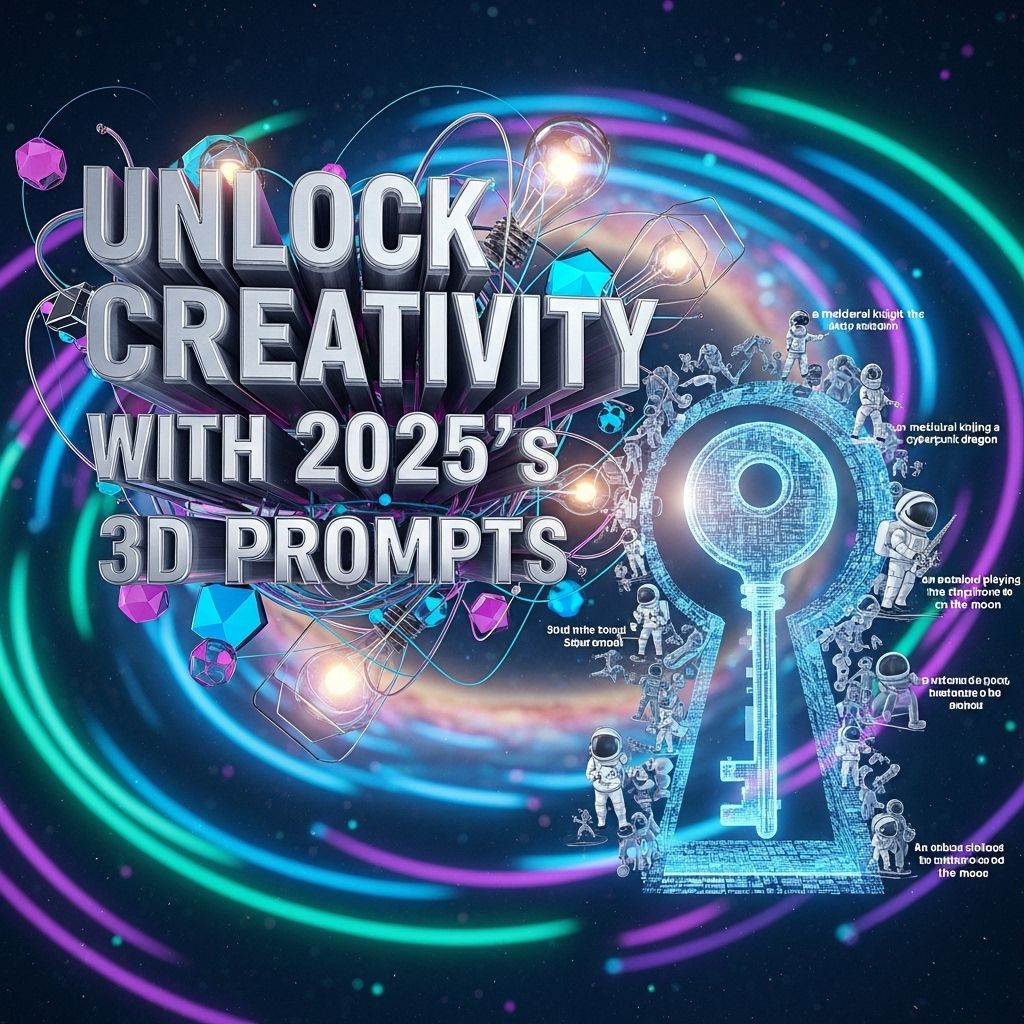As technology continues to evolve, so does the landscape of creativity. The advent of 3D modeling and rendering software has revolutionized how creators conceptualize and bring their ideas to life. By leveraging innovative 3D prompts in 2025, artists, designers, and developers can unlock unprecedented levels of creativity. This article explores some of the most exciting 3D prompts that are set to dominate the creative scene in the near future.
The Evolution of 3D Creativity
The journey of 3D creativity dates back to the early days of computer graphics, where limited capabilities constrained artists to simplistic designs. However, advancements in technology have led to sophisticated tools that empower creators to design intricate 3D worlds. In 2025, we can expect the following trends to shape the creative environment:
- High-Resolution Textures: The ability to incorporate hyper-realistic textures enhances detail.
- AI-Assisted Design: Artificial Intelligence tools that suggest design elements or automate repetitive tasks.
- Virtual Reality Integration: The use of VR to visualize and interact with 3D models in immersive environments.
Unleashing Imagination with 3D Prompts
3D prompts serve as catalysts for imagination, helping creators push the boundaries of their artistic capabilities. Below are some engaging prompts that can ignite creativity:
1. Surreal Environments
Imagine creating a scene where gravity behaves differently or where everyday objects take on fantastical forms. Surreal environments challenge the creator to think outside traditional constraints.
2. Character Design Mashups
Combine traits from various characters in pop culture or mythology to create a unique hero or villain. Consider blending:
- A classic hero from comic books with a mythical creature.
- A futuristic robot with vintage clothing.
- A renowned historical figure depicted as a modern-day influencer.
3. Dynamic Product Displays
Create eye-catching 3D models for product displays that entice customers. Incorporate motion and interactivity into your designs. Some ideas include:
| Product Type | Display Concept |
|---|---|
| Sneakers | Rotate to showcase every angle with interactive lighting. |
| Tech Gadgets | Use animations to highlight features and functionality. |
| Fashion Apparel | Showcase a 360-degree view, allowing users to mix and match outfits. |
Tools for 3D Creation in 2025
With a myriad of tools available, selecting the right software is crucial for maximizing creativity. Below are some standout programs that will be popular in 2025:
- Blender: An open-source platform recognized for its robust modeling capabilities and community support.
- Autodesk Maya: Industry-standard software for animation, boasting advanced features for character rigging.
- Cinema 4D: Favored for motion graphics, offering intuitive controls for creating eye-catching visuals.
- SketchUp: Excellent for architectural modeling with a user-friendly interface.
Collaborative Creativity
The future of 3D creativity is not just about individual efforts; collaboration is increasingly becoming a norm in the creative process. Tools and platforms that facilitate online collaboration include:
- Figma: While primarily for UI/UX design, its plugins allow for 3D integrations.
- Miro: A collaborative whiteboard tool that can be used for brainstorming and designing together in real time.
- Unity: Ideal for game development, Unity allows teams to build and share 3D environments interactively.
Trends Shaping the Future of 3D Design
As we look towards the future, several key trends are emerging that will influence 3D creativity:
Sustainability
With a growing focus on environmental issues, creators are encouraged to consider sustainable materials and practices in their designs.
Augmented Reality (AR)
The integration of AR into 3D prompts will allow users to visualize designs in real-world settings, enhancing user interaction.
Gamification in Design
Gamifying the design process can increase engagement and motivation among creators, making the journey of creativity more enjoyable.
Conclusion
In 2025, the fusion of technology and creativity will open up endless possibilities for artists and designers alike. By embracing innovative 3D prompts and leveraging advanced software, creators can unlock new realms of imagination, collaboration, and expression. As we continue to explore this dynamic landscape, the potential for groundbreaking designs and creative breakthroughs is limited only by our imagination.
FAQ
What are 3D prompts and how can they enhance creativity?
3D prompts are creative challenges or ideas designed to inspire artists and creators to think outside the box by incorporating three-dimensional elements into their work. They challenge traditional perspectives and encourage innovative thinking.
How can I use 3D prompts to improve my artistic skills?
Using 3D prompts can help you practice spatial awareness, explore new techniques, and experiment with different materials. By regularly engaging with these prompts, you can refine your skills and expand your creative toolkit.
Where can I find 3D prompts for my projects in 2025?
You can find 3D prompts on various online platforms, including social media groups, art forums, and dedicated creative websites. Many art communities share weekly or monthly prompts to inspire creators.
Can 3D prompts be used in digital art creation?
Absolutely! 3D prompts are perfect for digital art creation, allowing artists to utilize software and tools to create stunning three-dimensional visuals, animations, and designs.
What are some examples of 3D prompts I can try?
Examples of 3D prompts include creating a futuristic cityscape, designing an underwater world, or sculpting an abstract piece that plays with light and shadow. Feel free to mix themes and styles!
How do 3D prompts foster collaboration among artists?
3D prompts often encourage collaboration by bringing artists together to share their interpretations and techniques. This communal approach can lead to new ideas and creative partnerships.

